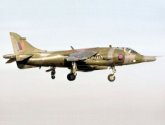
 The P.1127
prototype, an in-house development by Hawker-Siddely first hovered
on October 21, 1960. The Kestral, utilising the improved Pegasus
5 was then developed, and tested on a tripartite basis (UK, USA,
FDR), from March 7, 1964. A P1127(RAF) was developed from the
ARS.384 requirement, which saw the lightweight Kestral redesigned
to a more military standard. The resulting Harrier then flew
on August 31, 1966, and went into production a year later. Subsequent
revisions have seen the aircraft serving with the RAF to the
present day, and with the services of two other nations - Spain
and the USA. The GR3 model illustrated below is a GR1/1a with
upgraded engine and systems. The original Pegasus 6 Mk102 (19,000lb
st) or Pegasus 10 Mk102 (20,500lb st) was replaced with the Pegasus
11 Mk 103. The systems changes included the addition of a radar
warning receiver and the laser nose. 56 aircraft were converted,
and a further 36 aircraft built to GR3 specification.
The P.1127
prototype, an in-house development by Hawker-Siddely first hovered
on October 21, 1960. The Kestral, utilising the improved Pegasus
5 was then developed, and tested on a tripartite basis (UK, USA,
FDR), from March 7, 1964. A P1127(RAF) was developed from the
ARS.384 requirement, which saw the lightweight Kestral redesigned
to a more military standard. The resulting Harrier then flew
on August 31, 1966, and went into production a year later. Subsequent
revisions have seen the aircraft serving with the RAF to the
present day, and with the services of two other nations - Spain
and the USA. The GR3 model illustrated below is a GR1/1a with
upgraded engine and systems. The original Pegasus 6 Mk102 (19,000lb
st) or Pegasus 10 Mk102 (20,500lb st) was replaced with the Pegasus
11 Mk 103. The systems changes included the addition of a radar
warning receiver and the laser nose. 56 aircraft were converted,
and a further 36 aircraft built to GR3 specification.
Nation of Orgin: England
Constructor: Hawker-Siddely (later named British Aerospace, BAc)
Crew: 1
Span: 7.70m (25'3ft)
Length: 14.27m (46'10ft)
Height: 3.5m (11'4ft)
Empty weight: 5624kg (12,400lb)
Max weight: 11,794kg (26,000lb)
Power Plant: 21,500 lb st (9752kgp) RR Pegasus 103 F402-RR-401)
vectored thrust turbofan
Speed: 1183km/h (735mph)
Ceiling: 51200ft (15600m)
Range: 644km (400miles)